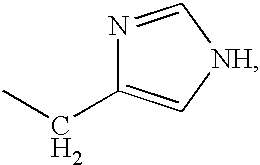Thioester-terminated water soluble polymers and method of modifying the N-terminus of a polypeptide therewith
a water soluble polymer and thioester technology, applied in the field of water soluble polymers, can solve the problems of partial or complete loss of the therapeutic utility of the conjugated protein, undesirable random pegylation approaches,
- Summary
- Abstract
- Description
- Claims
- Application Information
AI Technical Summary
Benefits of technology
Problems solved by technology
Method used
Image
Examples
example 1
Preparation of PEG(5000)-α-methoxy-ω-propionic Acid, 2-pyridylthioester (PEG-PA-OPTE)
[0158]
[0159]2-mercaptopyridine (40.0 mg, 0.36 mmoles), 1-hydroxybenzotriazole (4.0 mg, 0.030 mmoles), 4-(dimethylamino)pyridine (36.7 mg, 0.30 mmoles) and 1,3-dicyclohexylcarbodiimide (dissolved in 2 mL anhydrous dichloromethane, 84.0 mg, 0.41 mmoles) were added to a solution of PEG(5000)-α-methoxy-ω-propionic acid (1.5 g, 0.27 mmoles) in anhydrous acetonitrile (20 mL). The reaction solution was stirred overnight at ambient temperature under argon. The solution was then concentrated to near dryness at reduced pressure, followed by addition of anhydrous toluene (50 mL). The mixture was stirred at room temperature for thirty minutes, filtered and the filtrate was concentrated at reduced pressure to near dryness. Ethyl acetate (200 mL) was added and the mixture was warmed until the contents were completely dissolved. The solution was then cooled to room temperature while stirring. Ethyl ether (50 mL) w...
example 2
Preparation of PEG(5000)-α-benzyloxy(BZO)-ω-carboxymethyl, 2-pyridylthioester (PEG-CM-OPTE)
[0160]
[0161]2-mercaptopyridine (40.0 mg, 0.36 mmoles), 1-hydroxybenzotriazole (5.0 mg, 0.035 mmoles), and 1,3-dicyclohexylcarbodiimide (dissolved in 2 mL anhydrous dichloromethane, 74.3 mg, 0.36 mmoles) were added to a solution of PEG(5000)-α-benzyloxy-ω-carboxymethyl (1.5 g, 0.30 mmoles) in anhydrous acetonitrile (20 mL). The reaction solution was stirred overnight at ambient temperature under argon. The solution was then concentrated to near dryness at reduced pressure, followed by addition of anhydrous toluene (30 mL). The mixture was stirred at room temperature for thirty minutes, filtered and the filtrate was concentrated at reduced pressure to near dryness. Ethyl acetate (150 mL) was added and the mixture was warmed until the contents were completely dissolved. The solution was then cooled to room temperature while stirring. Ethyl ether (50 mL) was added to the solution and a precipitate...
example 3
Preparation of PEG(5000)-α-methoxy-ω-2-methyl butanoic acid, 2-pyridylthioester
[0162]
[0163]2-mercaptopyridine (44.5 mg, 0.40 mmoles), 1-hydroxybenzotriazole (4.7 mg, 0.033 mmoles), 4-(dimethylamino)pyridine (40.7 mg, 0.33 mmoles) and 1,3-dicyclohexylcarbodiimide (dissolved in 2 mL anhydrous dichloromethane, 92.8 mg, 0.45 mmoles) were added to a solution of PEG(5000)-α-methoxy-ω-2-methyl butanoic acid (1.5 g, 0.30 mmoles) in anhydrous acetonitrile (20 mL). The reaction solution was stirred overnight at ambient temperature under argon. The solution was then concentrated to near dryness at reduced pressure, followed by addition of anhydrous toluene (50 mL). The mixture was stirred at room temperature for thirty minutes, filtered and the filtrate was concentrated at reduced pressure to near dryness. Ethyl acetate (150 mL) was added and mixture was warmed until the contents completely dissolved. The solution was then cooled to room temperature while stirring. A precipitate was formed by ...
PUM
| Property | Measurement | Unit |
|---|---|---|
| molecular weight | aaaaa | aaaaa |
| molecular weight | aaaaa | aaaaa |
| pH | aaaaa | aaaaa |
Abstract
Description
Claims
Application Information
 Login to View More
Login to View More - R&D
- Intellectual Property
- Life Sciences
- Materials
- Tech Scout
- Unparalleled Data Quality
- Higher Quality Content
- 60% Fewer Hallucinations
Browse by: Latest US Patents, China's latest patents, Technical Efficacy Thesaurus, Application Domain, Technology Topic, Popular Technical Reports.
© 2025 PatSnap. All rights reserved.Legal|Privacy policy|Modern Slavery Act Transparency Statement|Sitemap|About US| Contact US: help@patsnap.com



